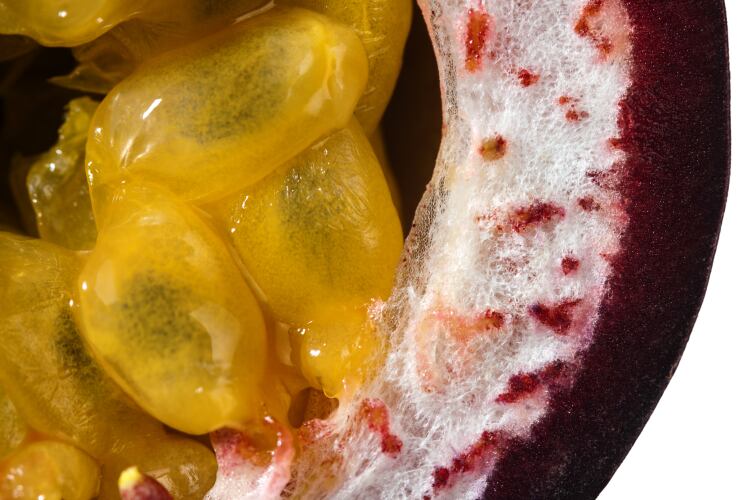Globally, passion fruits are mainly grown to produce concentrated fruit. Commercial processing of yellow passion fruit yields 36% juice, 51% rinds and 11% seeds.
The peel of the fruit is therefore a high-volume side stream of the juicing process that, today, largely goes to waste. Researchers at the University of Johannesburg believe they may have discovered a new use for this by-product that could itself help to cut spoilage in produce supply chains.
The team extracted micro-encapsulated, freeze-dried and powdered passion fruit (Passiflora edulis Sims) peels from an organic farm. Their metabolomic and other analyses, published in journal Antioxidants, show the powders have the properties needed for a quality, stable, edible food coating. The powders can also be functional ingredients in natural food additives, they noted.
A natural alternative to plastic?
When fresh produce is packaged in plastic it creates a ‘micro-atmosphere’ that slows oxidisation, explained Professor Olaniyi Fawole, from the University of Johannesburg.
“Oxygen is the bad guy, it causes a lot of biochemical degradation. So, we want to limit the oxygen that gets to the produce. And we also want to limit dehydration. Edible food coatings can potentially solve both the oxygen and dehydration problems in the cold chain,” he said. “If you coat the product, you reduce the interference from a high oxygen atmosphere, because there is a barrier. Dehydration is prevented because the coating keeps the moisture on the inside.”
However, any such coating needs to have high antioxidant content to help prevent spoilage due to oxidation and should also contain antimicrobials. An edible coating should not interfere with the colour, appearance or taste of the product, the researchers noted.
Microencapsulation to preserve antioxidants and polyphenols
The researchers discovered a microencapsulation process preserves the high antioxidant and polyphenol content from the passion fruit peels. This is significant, because antioxidants and other bioactive compounds are easily destroyed by industrial processes, pH, high storage temperature, oxygen, light, solvents, and metal ions.
One of three carriers for the microencapsulation were used during the study: gum arabic, maltodextrin, or waxy starch. When the researchers measured the encapsulation efficiency of each carrier, the found it ranged from 82.64% to 87.18%. “This indicates that antioxidants and polyphenols should be well preserved within the microcapsules of the coated powder particles,” they concluded.
Bioactive analysis results
The next step was to analyse each encapsulated powder in turn for antioxidants and polyphenol content.
Phytochemicals such as polyphenols are numerous in plants and no single analysis can describe the antioxidant content of the powders. Instead, the researchers used two analyses to indicate to what extent the encapsulation process affected the antioxidant activity of the bioactive compounds contained in the microparticles.
The first analysis, DPPH radical scavenging activity, showed that all three carriers possessed 45.85 to 51.29mM Trolox Equivalent (TE)/g DM (WS). Trolox is a synthetic water-soluble antioxidant that has been used as a standard antioxidant for these comparisons. The second analysis, ferric reducing antioxidant power (FRAP), showed that the carriers possessed 32.30 - 37.47mM TE/ g DM.
Natural antioxidant potential
The researchers noted their findings point towards the potential for passion fruit peel to be commercially developed as a natural antioxidant. This is particularly interesting given the drive towards alternatives to synthetic antioxidants, which have increasingly seen their safety could be questioned by consumers.
“The results mean that the encapsulated powders could be viable alternatives to synthetic antioxidants and can provide valuable properties such as ant browning and anti-senescence behaviour. They also offer the additional benefit of being edible,” said Professor Fawole.
To identify which polyphenols are present in the microencapsulated powders, the researchers ran metabolomic analyses, using liquid chromatography mass spectrometry (LC-MS). ‘Commercially important’ polyphenols preserved in the microencapsulated powders at useful levels are vanillic acid glucoside, quercetin, citric acid, gluconic acid and caffeic acid.
'Long' shelf life and 'excellent' solubility
Professor Fawole stressed that any preservative needs to be stable and offer a long shelf life. “An edible coating or natural food preservative may be potent, but if its raw material is not stable, it is useless. For example, if it is hygroscopic, meaning it absorbs moisture, it is not suitable for industrial scale applications,” he noted.
“These microencapsulated powders are non-hygroscopic, for all three carriers. If these are well-packaged, and stored cool and dry, they should last up to six months. Also, you can open up a container, use what you need, close the container, and the rest will be stable. It won’t be necessary to use the contents of an entire container in one go.”
Overall, the detailed laboratory results indicate that microencapsulated powders from passion fruit peels are highly suitable as an active ingredient in edible food coatings, and natural food additives, particularly for ‘naked’ fresh fruit and fresh cuts, he concluded.
Source
‘Micro-Encapsulation of Phytochemicals in Passion Fruit Peel Waste Generated on an Organic Farm: Effect of Carriers on the Quality of Encapsulated Powders and Potential for Value-Addition’
Antioxidants
Gift Kabelo Kobo, Tafadzwa Kaseke and Olaniyi Amos Fawole
DOI: 10.3390/antiox11081579


